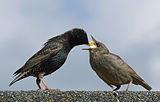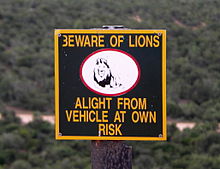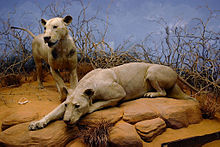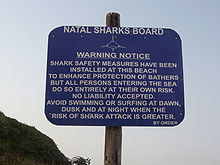- Man-eater
-
For other uses, see Maneater.
Man-eater is a colloquial term for an animal that preys upon humans. This does not include scavenging. Although human beings can be attacked by many kinds of animals, man-eaters are those that have incorporated human flesh into their usual diet. Most reported cases of man-eaters have involved tigers,[1] leopards,[1] lions and crocodilians. However, they are by no means the only predators that will attack humans if given the chance; a wide variety of species have also been known to take humans as prey, including bears, large constricting snakes (such as boas and pythons), Komodo dragons, wolves, hyenas, other big cats, sharks, and even other humans.
Contents
List of man-eaters
Big cats
Tigers
Main article: Man-eating tigersTigers are recorded to have killed more people than any other big cat. Unlike leopards and lions, man-eating tigers rarely enter human habitations in order to acquire prey. The majority of victims are reportedly in the tiger's territory when the attack takes place.[2] Plus, tiger attacks mostly occur during daylight hours, unlike those committed by leopards and lions.[2] The Sundarbans are home to approximately 600 Royal Bengal Tigers[3] that are well-known for the substantial number of people they kill;[citation needed] estimates range from 50-250 people per year.[citation needed] They are the only man-eating tigers left in the world,[citation needed] though they are not the only tigers who live close to humans. A theory promoted to explain this suggests that since tigers drink fresh water, the salinity of the area waters serve as a destabilizing factor in the diet and life of tigers of Sundarbans, keeping them in constant discomfort and making them extremely aggressive. Other theories include the sharing of their habitat with human beings and the consumption of human corpses during floods.[3]
Lions
Man-eating lions are reportedly bolder and more aggressive than tigers, having been recorded to actively enter human villages at night to acquire prey. This greater assertiveness usually makes man-eating lions easier to dispatch than tigers. Lions typically become man-eaters for the same reasons as tigers: starvation, old age and illness, though as with tigers, some man-eaters, including the Tsavo lions, were reportedly in perfect health.[2] The lion's proclivity for man-eating has been systematically examined. American and Tanzanian scientists report that man-eating behavior in rural areas of Tanzania increased greatly from 1990 to 2005. At least 563 villagers were attacked and many eaten over this period—a number far exceeding the more famed "Tsavo" incidents of a century earlier. The incidents occurred near Selous National Park in Rufiji District and in Lindi Province near the Mozambican border. While the expansion of villagers into bush country is one concern, the authors argue that conservation policy must mitigate the danger because, in this case, conservation contributes directly to human deaths. Cases in Lindi have been documented where lions seize humans from the center of substantial villages. It is estimated that 550-700 people are attacked by lions every year.[4]
- Tsavo maneaters
- Mfuwe maneater
Leopards
Jim Corbett was noted to have stated that unlike tigers which usually became man-eaters because of infirmity, leopards more commonly did so after scavenging on human corpses; in the area that Corbett knew well, dead people are usually cremated completely, but when there is a bad disease epidemic, the death rate outruns the supply of cremation pyre wood and people burn the body a little and throw it over the edge of the burning ghat.[5] In Asia, man-eating leopards usually attack at night, and have been reported to break down doors and thatched roofs in order to reach human prey. Attacks in Africa are reported less often, though there have been occasions where attacks occurred in daylight.
- Leopard of the Central Provinces
- Leopard of Gummalapur
- Leopard of Panar
- Leopard of Rudraprayag
- Leopard of the Yellagiri Hills
Canids
Wolves
 Two of the Wolves of Périgord, responsible for the deaths of 18 people in February 1766, on display at the chateau of Razac in Thiviers.
Two of the Wolves of Périgord, responsible for the deaths of 18 people in February 1766, on display at the chateau of Razac in Thiviers.
Contrasted to other carnivorous mammals known to attack humans for food, the frequency with which wolves have been recorded to kill people is rather low, indicating that though potentially dangerous, wolves are among the least threatening for their size and predatory potential. In the rare cases in which man-eating wolf attacks occur, the majority of victims are children.[6] Habituation is a known factor contributing to some man-eating wolf attacks which results from living close to human habitations, causing wolves to lose their fear of humans and consequently approach too closely, much like urban coyotes. Habituation can also happen when people intentionally encourage wolves to approach them, usually by offering them food, or unintentionally, when people do not sufficiently intimidate them.[6] This is corroborated by accounts demonstrating that wolves in protected areas are more likely to show boldness toward humans than ones in areas where they are actively hunted.[7]
- Beast of Gévaudan
- Kirov wolf attacks
- Wolf of Ansbach
- Wolf of Gysinge
- Wolf of Sarlat
- Wolf of Soissons
- Wolves of Ashta
- Wolves of Turku
- Wolves of Hazaribagh
- Wolves of Paris
- Wolves of Périgord
Bears
Main article: Bear attacksWhile bears rarely attack humans, when attacks do occur they are often fatal due to the size and immense strength of bears. Truly man-eating bears are uncommon but are known to occur when the animals are diseased or natural prey is scarce, often leading bears to attack and eat anything they are able to kill. In July 2008, dozens of starving bears killed several armed Russian security guards working at a salmon hatchery in Kamchatka.[8] After the partially-eaten remains of two workers were discovered, authorities responded by sending out a team of snipers to hunt down the bears.[9]
Though usually shy and cautious animals, Asian black bears are more aggressive toward humans than the brown bears of Eurasia.[10] As a rule, brown bears seldom attack humans on sight, and usually avoid people. They are however unpredictable in temperament, and will attack if they are surprised or feel threatened.[11] In some areas of India and Burma, sloth bears are more feared than tigers, due to their unpredictable temperament.[12]
Other man-eaters
Sharks
Contrary to popular belief, only a few sharks are dangerous to humans. Out of more than 360 shark species, only four have been involved in a significant number of fatal unprovoked attacks on humans: the great white shark, tiger shark, bull shark,[13], and the oceanic whitetip shark.[14] These sharks, being large, powerful predators, may sometimes attack and kill people; however, they have all been filmed in open water by unprotected divers.[15][16] Most of the oceanic whitetip shark's attacks have not been recorded,[14] unlike the other 3 species mentioned above.
Crocodiles
Crocodile attacks on people are common in places where crocodiles are native. The Saltwater and Nile Crocodiles are responsible for more attacks and more deaths than any other wild predator that attacks humans for food. Each year, hundreds of deadly attacks are attributed to the Nile Crocodile within sub-Saharan Africa. The fact that there are many relatively healthy populations of Nile Crocodiles in East Africa and their proximity to people living in poverty and/or without infrastructure has made it likely that the Nile Crocodile is responsible for more attacks on humans than all other species combined.
Snakes
While only a very few species of snakes can swallow a human, the technicality regarding a snake swallowing its prey head first, prevents it from preying on adult human beings. Quite a few claims have been made about giant snakes swallowing adult humans, although convincing proof has been absent. Scientifically, such a situation seems to be very unlikely. However, big constrictors shall have no problems swallowing an infant or a small child, a threat that is legitimate and empirically proved. The only family of snakes that are able to eat an adult human being are constrictors (three pythons and one boa, all non-venomous):
- Reticulated Python
- Green Anaconda
- African Rock Python
- Burmese Python
Lizards
The Komodo Dragon is capable of, and has been known to, attack and eat humans. [citation needed]
Catfish
There are reports of goonch catfish eating humans in the Kali River in India.[17]
Perception
Attacks on human beings for food have caused the demonizing of the predatory animals in question.[18] The fear caused by the prospect of an attack has encouraged the hunting of tigers, leopards and lions for sport and the extermination or driving out of predatory animals from territories close to human settlement; the harassment and hunting of such animals has been coupled with the destruction of their natural habitats.
Fear of attacks on humans has inspired folklore, superstition, legends and tales characterizing large predatory animals capable of killing and eating humans (dogs usually excluded) as evil.[1] The Jersey shore shark attacks inspired the use of sharks as symbols of evil, enemies in political cartoons, and caricatures of all kinds of negative events.[19]
See also
- Dingo of Ayers Rock
- Kali river goonch attacks
- Malawi terror beast
- Donner Party
References
- ^ a b c Corbett, Jim (1944). Man-eaters of Kumaon. Oxford University Press. pp. viii-xiii.
- ^ a b c John Seidensticker and Susan Lumpkin (1991). Great Cats. pp. 240. ISBN 0878579656.
- ^ a b Theories on Sundarbans Man-eaters
- ^ Packer, C.; Ikanda, D.; Kissui, B.; Kushnir, H. (August 2005). "Conservation biology: lion attacks on humans in Tanzania". Nature 436 (7053): 927–928. doi:10.1038/436927a. PMID 16107828.
- ^ books by Jim Corbett
- ^ a b "The Fear of Wolves: A Review of Wolf Attacks on Humans" (PDF). Norsk Institutt for Naturforskning. http://www.nina.no/archive/nina/Publikasjoner/oppdragsmelding/NINA-OM731.pdf. Retrieved 2008-06-26.
- ^ L. David Mech & Luigi Boitani (2001). Wolves: Behaviour, Ecology and Conservation. pp. 448. ISBN 0226516962.
- ^ Dovbysh, Alexei (July 22, 2008). "Russian bears trap geology survey crew". Reuters. http://www.reuters.com/article/idUSL22583868. Retrieved 24 April 2010.
- ^ Harding, Luke (23 July 2008). "Bears eat two men in Russia's eastern wilderness". The Guardian. http://www.guardian.co.uk/world/2008/jul/23/russia.animalbehaviour. Retrieved 24 April 2010.
- ^ Bear Anatomy and Physiology from Gary Brown's The Great Bear Almanac, Lyons & Burford, Publishers, 1993
- ^ Bear Attacks: Their Causes and Avoidance by Stephen Herrero, Hurtig Publishers Ltd./ Edmonton 1985
- ^ Perry, Richard (1965). The World of the Tiger. pp. 260. ASIN: B0007DU2IU.
- ^ ISAF Statistics on Attacking Species of Shark
- ^ a b http://animals.howstuffworks.com/fish/most-dangerous-shark2.htm
- ^ Hawaiian newspaper article
- ^ The 1992 Cageless shark-diving expedition by Ron and Valerie Taylor.
- ^ Mutant fish develops a taste for human flesh in India
- ^ Clarke, James (1969). Man is the prey: an investigation into the motives and habits of man's natural enemies. ISBN 233960872.
- ^ Fernicola, Twelve Days of Terror, p. 33.
Feeding behaviours Carnivores adultHematophagy · Insectivore · Lepidophagy · Man-eater · Molluscivore · Mucophagy · Myrmecophagy · Ophiophagy · Piscivore · Avivore · Spongivore · Vermivore · Herpetivorereproductivecannibalistic
Herbivores Others Methods Apex predator · Bait balls · Bottom feeding · Browsing · Feeding frenzy · Filter feeding · Grazing · Hypercarnivore • Intraguild predation · Kleptoparasitism · Scavenging · TrophallaxisPredation · Antipredator adaptation · Carnivorous plant · Carnivorous fungus · Carnivorous protist · Category:Eating behaviors Categories:- Man-eaters
- Animals
- Animal attacks
- Anthropophagy
- Donner Party
Wikimedia Foundation. 2010.




